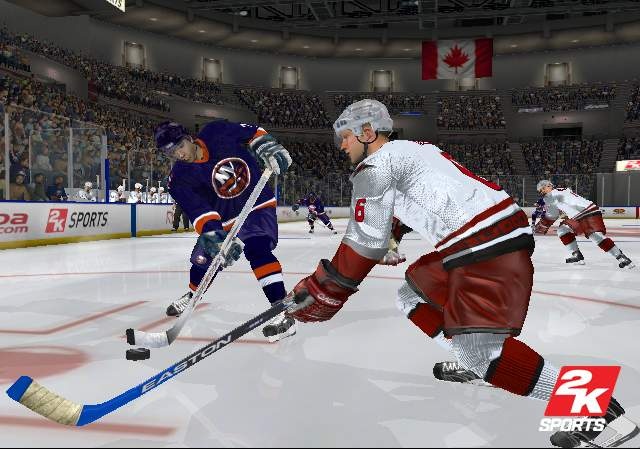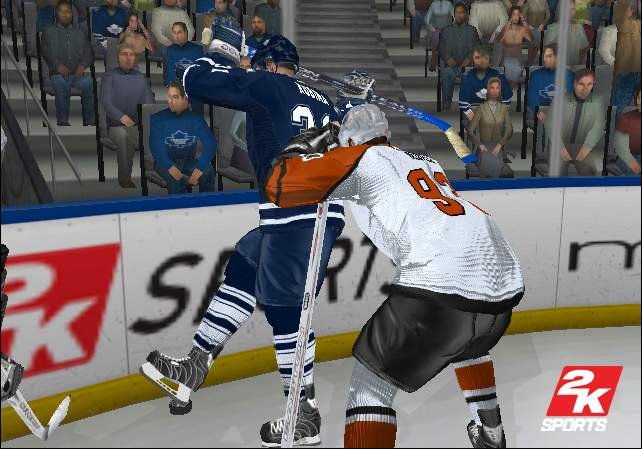We're headlong into the push toward next-generation consoles, and as a result, the older consoles are beginning to get the short shrift. For instance, while Xbox 360 versions of major sports games are seeing big upgrades in gameplay and visuals, Xbox, PlayStation 2, and GameCube versions are practically the same games from the previous year with little in the way of alteration. NHL 2K7 for the Xbox is a perfect example of this. Though it includes a few of the smaller updates included in its Xbox 360 counterpart, it lacks any of the major changes, leaving you with a solid game of hockey that will impress someone unfamiliar with the NHL 2K series but that will probably leave some longtime fans feeling cold.

The big change to the 360 version this year, the new "cinemotion" presentation system, isn't available in the Xbox version of the game. You do, however, get the new camera angle, which is possibly the best camera angle included in a hockey game to date. This parametric camera comes down at more of an angle than the typical top-down camera view, and turns and zooms ever so subtly depending on where you are on the ice, and what's happening. It's the sort of thing that casual fans might not even notice or take note of initially, but dedicated players should certainly appreciate this change, since it gets you just that much closer to the action without sacrificing any level of control or visibility.
On the gameplay front, just about every feature from last year's game, including the crease control, icon passing, enforcer, and on-the-fly play-calling systems return once more, and they're all basically the same. One new addition to the game is the new pressure control scheme. If you find yourself having particular trouble with on individual opponent, you can order your teammates to pressure them by holding down the left bumper and pressing the right control stick in the direction of that opponent. You can set the level of pressure via taps of the left bumper. A single tap applies light pressure, a double tap applies more physical pressure, and repeatedly tapping sends your players in for a very hard check. You can cycle through opponents easily enough by simply tapping the right stick around while holding the bumper.
Pressure controls, much like many of the previously mentioned gameplay control systems, aren't exactly amazing by themselves, but when combined with the wealth of other available options, they help make NHL 2K7 one of the smartest games of hockey around, if not the flashiest. The basic gameplay engine hasn't really changed dramatically in the last couple of years, and those familiar with how 2K hockey plays will find yet another game of 2K hockey in this year's offering. Of course it's hard to call that a bad thing, since the depth of play, especially in the defense and core strategies of the game of hockey, is unmatched by any other available hockey title on the market. But when it comes to some of the faster and more exciting aspects of hockey, like scoring, offensive moves, and fighting, little has changed, and these aspects of the game engine are starting to show their age.
2K7's feature list is also quite familiar. Party mode returns with a familiar roster of hockey-based minigames; mini rink and pond hockey provide similarly goofy yet enjoyable distractions; and the skybox once again houses all sorts of unlockables, statistics, and other fun things. Franchise mode returns with most of the same great features introduced last year, as well as a few small additions. A hard salary cap has been implemented for all teams in the game, though it's not detailed in the ways of the NHL collective bargaining agreement. It is still displayed as a basic budget, and there isn't a realistic contract system in the game with regard to sending players to the minors or letting them go. You can't sign two-way deals, so you can send a player to the minor leagues or cut him outright, without having to put him through waivers.
On the plus side, the franchise mode still has an excellent rookie scouting system, a solid free agency interface, and a minor league roster to keep track of as the season progresses. Trade logic is still solid, if a bit overly frequent in its offers. Though you rightfully get plenty of offers right near the trade deadline, you also get a lot of offers throughout the season, perhaps a few more than is even realistic. Injuries occur mostly in a realistic fashion, though you'll sometimes find an over proliferation of minor injuries like broken hands and bruised faces, and that they sometimes take overly long to heal.
Other additions include a more-emphasized rivalry system that creates statistical bonuses and takeaways depending on how players play in games against their rival teams. We all know how much the NHL loves its rivalries, and with this system, players are physically affected by how they play in rivalry games. Another addition involves messages from the team owner. Along with receiving the typical day-to-day e-mails, you also have an option called "opportunity knocks." Here, you'll get specific bonuses and takeaways for various players based on news delivered to you by the owner via a cell phone call. For instance, if one of your players just got a sponsorship for a new energy drink, his attributes will go up for the next few games. Or, conversely, if one of your players looks ragged and tired, his attributes will go down for a few games. It's sort of random as to which way a call will go, and the only way to avoid bad ones is to not receive the calls at all. Of course, if you do that, you won't get the good ones either, so it's up to you to decide whether it's worth the risk. The bonuses offered are rarely significant enough to make it worthwhile to take time out of your schedule to check the feature.
The online-play setup is very much how it has been the last couple of years. Basic competition is available for two to eight players (four to a console), and you can engage in competitions of varying difficulty levels, with or without the crease control turned on. The party games and minirink modes are also available online. Most importantly, online league play is once again available for tournaments or full seasons and involves anywhere from four to 30 teams. The options for leagues haven't changed much, though with so many options available for scheduling and stat tracking via the 2K Sports Web site, it's hard to complain, considering there's still nothing else like it available in other hockey games for consoles. But it would be nice if in the future some little features could be included, like fantasy drafts, free-agent pools, and the like. As far as how the online modes play, our experiences playing the game online yielded little to no lag.

While the graphics in the Xbox 360 version of 2K7 have seen a big step forward, the Xbox version looks like the Xbox game from last year. That's hardly surprising, since the game has consistently looked excellent for what the Xbox hardware is capable of, and it's still a great-looking game of Xbox hockey. Player models and jerseys are nicely detailed, animations are generally smooth, and the new camera angle makes the on-ice action look more attractive. On the audio front, Bob Cole and Harry Neale are on hand again for commentary duty, and functionally, it feels like much the same commentary as last year's game. It's sometimes informative, but mostly just serves as background fodder. The on-ice effects, however sound excellent, and the indie-rock heavy soundtrack is actually better than your average indie-rock heavy soundtrack, if only by a small margin. It consists exclusively of bands from the Sub Pop record label, and has songs by The Postal Service, Mudhoney, Hot Hot Heat, Band of Horses, Sealter-Kinney and more. It's really weird hearing Band of Horses and The Postal Service in a hockey game, but you could certainly do worse.
As disappointing as it is that the Xbox version of NHL 2K7 lacks any serious updates, it's hard to argue with the notion of focusing on the newer consoles, since the life span of the older ones is dwindling so quickly. For what it's worth, 2K7 on the Xbox costs only $19.99 at retail, versus the $59.99 price of the 360 version. You'll get significantly more out of the 360 version, but if you'd rather not spend the money, and you don't mind getting a largely recycled game (a great recycled game, mind you) with new rosters and a couple of neat tweaks, NHL 2K7 for the Xbox is worth a look.